Archiving and Pseudonymisation - Complete Guide
This guide will provide you with instructions and guidelines for Archiving and Pseudonymising your attendees. This feature will allow you to manage attendees that are no longer active or whose personal details you no longer wish (or no longer have permission) to keep.
Note: Only users with the System Admin role will be able to Pseudonymise attendees.
Archiving
The archiving feature will allow you to store attendees that are no longer actively engaging in your projects and activities. Their data remains but they are no longer directly accessible for day-to-day use. This should de-clutter your account and allow you to find the people you are searching for more quickly and easily.
Once an attendee is archived, you will no longer be able to:
-Find them in the search bar.
-Add them to registers.
-Send them a survey.
-Email them.
-Link them to media items.
It is important to note that archiving does not delete any personal or sessional data from your Upshot account. So, if you archive an attendee, you are still storing their personal information and historical data, such as:
- Submitted registers
- Timeline Events
- Completed survey responses
- Media items that they were already linked to
- Indicators
- People reports
- Attendance reports
- Statistics reports
- Map reports
- Written reports
Note: You can unarchive attendees at any time and they will once again be available in the functions listed above.
Archiving attendees
The following user roles can archive attendees:
- Project Manager
- Session Registrar
- Team Manager
You can either archive attendees in bulk or individually.
To BULK ARCHIVE attendees, go to the People Report.
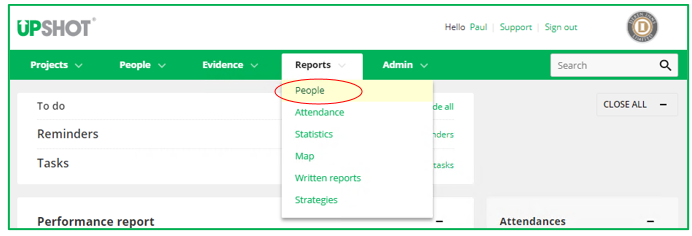
You will see that you can filter your attendees by Active only, Archived only and Active or archived.

Select Active only and continue to use the People report options to set criteria and find a specific group of attendees that you want to archive. Then click Go.
You will now have different options of what to do with the attendees that match your search results. If you want to exclude particular attendees from this list, just click on their name and they will be crossed off.
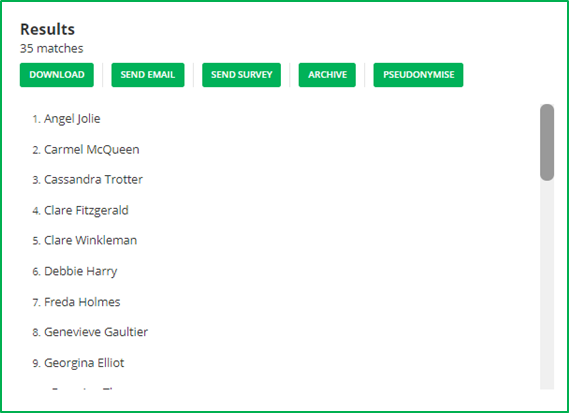
Click on Archive. The system will ask you to verify your selection. Click Yes, archive.
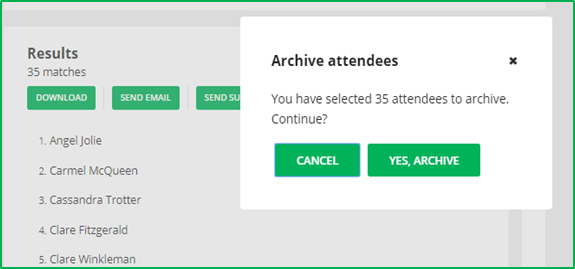
You will be taken to the Archived Attendee Management page. This can also be accessed from via People > Archived Attendees.

To INDIVIDUALLY ARCHIVE attendees, go to the profile of the attendee you want to archive. You can do so via the search bar in the top right-hand corner of every page.

Scroll down to Tools on the right-hand side of the profile and select Archive.
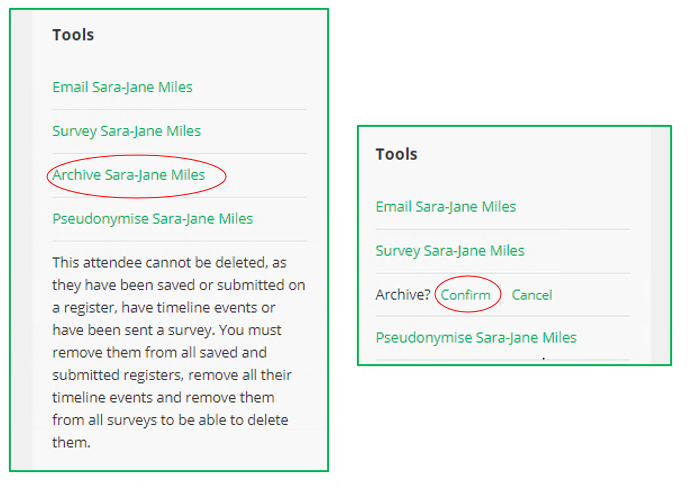
The system will ask you to confirm your selection. Click Confirm.
You will now be able to search for this attendee through the Archived Attendee Management page mentioned above. On their profile there is also a little red symbol next to their name and a notice to let you know this attendee has been archived.
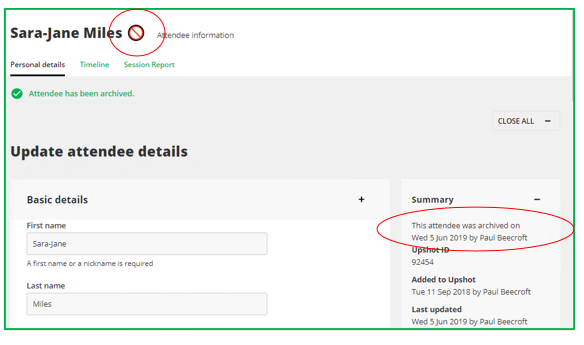
Unarchiving attendees
If you need to retrieve people out of the archive to be able to record data against them again, you can unarchive them. To do this:
- Go to the People > Archived attendees.

Search for the person you want to unarchive. You can list multiple people by searching for and selecting them individually. Click on the tick box of the attendees you want to unarchive.
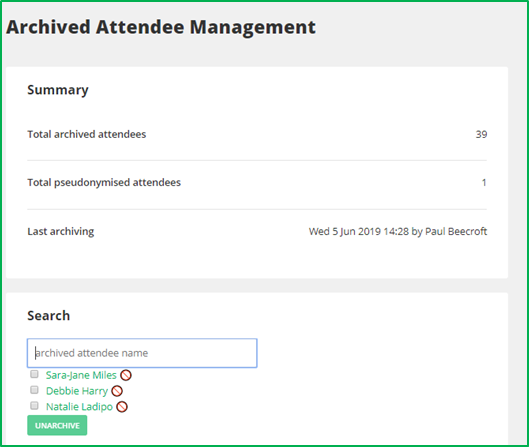
Once a person is selected, the Unarchive button will become available. Click on it and confirm your selection in the pop-up screen.
The attendee’s profile will now be available again in the Search bar and for all other functions.
Searching for archived attendees
If you want to see all the people you have archived, go to the People report and filter by Archived only. Then scroll down and click Go.
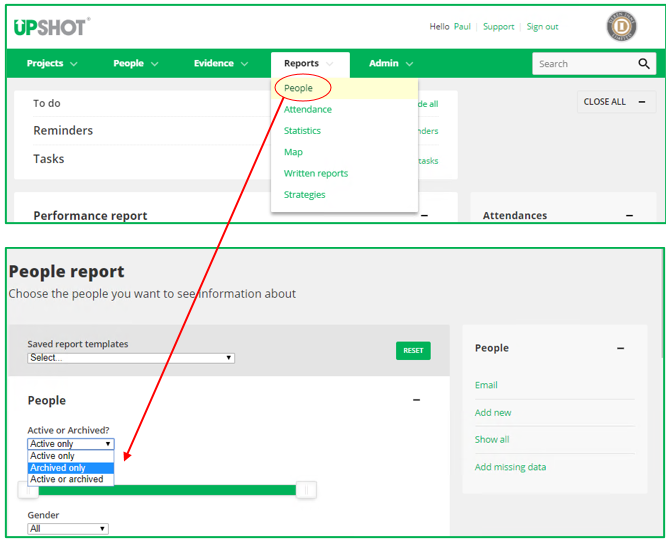
You will now see all archived attendees, marked with the little red circle symbol. You can download these into a spreadsheet file by clicking the Download button.

You will see that the downloaded People report will now feature two new columns, the Status column and the Archived on column.

Where archived attendees appear on registers, they will be filtered into a new section at the bottom of the Grid register. This is particularly useful when you have regular activities that have been occurring for a long time and old attendees were still showing on the register.

Pseudonymisation
Pseudonymisation is a technique that replaces or removes information that identifies an individual. The General Data Protection Regulation (GDPR) defines pseudonymisation as:
“…the processing of personal data in such a manner that the personal data can no longer be attributed to a specific data subject without the use of additional information, provided that such additional information is kept separately and is subject to technical and organisational measures to ensure that the personal data are not attributed to an identified or identifiable natural person.”
This allows you to delete personal information you no longer want or need to keep, without erasing the attendee’s participation data. Once attendees are pseudonymised they are instantly archived. This means they are no longer included in active searches, as per the list of functions below.
In addition, personal identifiers are deleted or scrambled and only historical participation data is retained. These deleted personal identifiers include:
- Names (first, last and nickname)
- Address (postcode is adjusted to a nearby one)
- Contact details
- Custom data fields
- Timeline events – all custom timeline event information and all notes associated to both global and custom timeline events.
- Media items only associated with the attendee
- Free text responses in surveys (other survey responses are retained)
Note: It is not possible to reverse pseudonymisation of an attendee. Once the system has removed the personal identifiers of an attendee, they cannot be recovered.
Note II: Only users with the System Admin role will be able to Pseudonymise attendees.
Note III: It is only possible to pseudonymise 'active' attendee profiles. Any previously archived attendees would need to be unarchived first, before being able to complete the pseudonymisation process.
Pseudonymising attendees
You will find the pseudonymisation tool in the same places as the archiving tool, via the people report or on an attendee’s profile. To pseudonymise attendees in bulk, go to the People tab and filter by the relevant criteria. Click GO to list the attendees that match your search criteria.
Click Pseudonymise.

The following notice will appear to inform you in detail about what pseudonymisation entails, what information is retained and whether the selected attendees have any media or surveys attached to them.
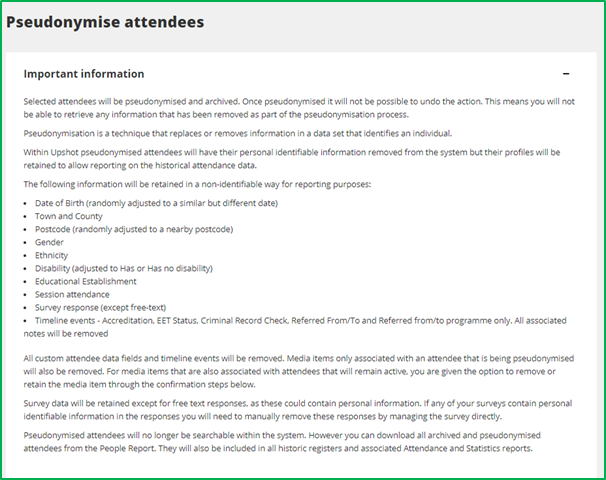
You are given the option to deselect any attendees you decide to keep as they are. If any attendees you have selected have surveys or media attached to them, this will be flagged on the right. By clicking on the drop-down arrow, a further panel opens that specifies what media and surveys are attached to that person.
If a media item is linked only to that individual, it can be deleted from Upshot by clicking on the deletion tick box. If the media is linked to multiple attendees, then only the association to the pseudonymised attendee will be removed. It is your responsibility to check that the media item does not include any personally identifiable information.
For completed surveys, only the free-text responses of the pseudonymised person will be removed. All selected options are kept.
Once you are happy you have selected all the right attendees and their associated media items, click on the confirmation tick and box and then Start Processing.
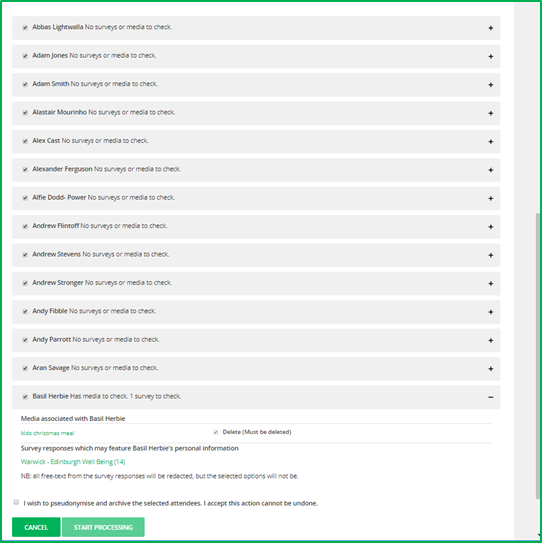
If you select a large number of attendees to pseudonymise, this might take a while to process. A processing queue is formed to track the progress. You can see this by going to People > Pseudonymisation queue.
Attendees can also be pseudonymised individually from their profile. You can search for them in the main Search bar.

Once on the attendee’s profile, scroll down to the Tools section and select Pseudonymise the system will take you to the same notice page as in the bulk selection and ask you to confirm your selection.

Finding Pseudonymised attendees
Note: The following is only available to System Admin users.
If you want to review which attendees have been pseudonymised in the past, you can download the pseudonymisation log as a spreadsheet (.csv) file. You can find this on the pseudonymisation queue page or from the Admin tab.
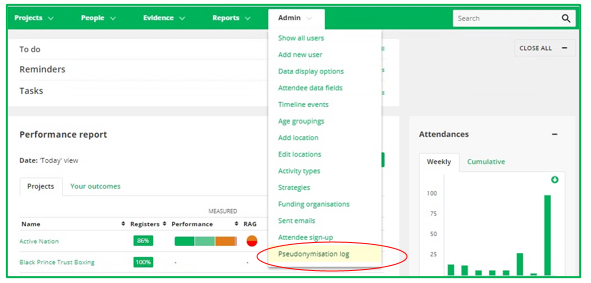
The log lists the name of the pseudonymised attendees and the date they were pseudonymised.

Reporting
For the vast majority of information, such as sessional data, users will still be able to include archived/pseudonymised attendees in their reports.
The Statistics Report and Measured Indicators for instance, includes participation data on all attendees.
The Timeline Events Report, will include all information on Timeline Events recorded, keeping in mind that Pseudonymising an Attendee removes lots of custom Timeline Events as described above.
Survey exports will include all results for archived attendees, and all apart from 'free text' for pseudonymised attendees.
On the People Report users have a filter at the very top of the screen to include Archived (and Pseudonymised) attendees in their query.
Key Terms
Archiving:
The archiving feature will allow you to store attendees that are no longer actively engaging in your projects and activities. Their data remains but they are no longer directly accessible for day-to-day use.
Archived Attendees:
These attendees can no longer be found in the search bar, added to registers or sent a survey. You can also no longer email them from the system or add media to their profile. These attendees will only be found by clicking on Archived Attendees and their archived status is indicated by a red no entry symbol next to their name. These archived attendees can be reported on using the People Report and can also be unarchived if required.
Pseudonymisation:
Pseudonymisation is a function that replaces or removes information that identifies an individual. This allows you to delete personal information you no longer want or need to keep, without erasing the attendee’s participation data. Once attendees are pseudonymised they are instantly archived. This means they are no longer included in active searches. In addition, personal identifiers are deleted or scrambled and only historical participation data is retained. It is not possible to reverse pseudonymisation of an attendee. Once the system has removed the personal identifiers of an attendee, they cannot be recovered.
Pseudonymisation Log:
The log lists the name of the pseudonymised attendees and the date they were pseudonymised.
Pseudonymisation Queue:
The attendees listed here are in the process of being pseudonymised.




















